Search the Special Collections and Archives Portal
Search Results
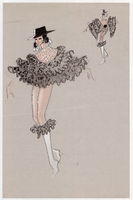
Costume design drawing, black ruffled Spanish flamenco costume with brimmed hat and lace detailing, circa 1965-75
Date
1965 to 1975
Archival Collection
Description
Costume Details: Black and white Spanish flamenco female dancer costume with oversized black ruffled sleeves, a white net top, black ruffles at the knees, white boots, and a black brimmed hat, shown front and back.
Image
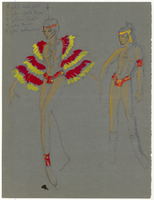
Costume design drawing, female and male Indian costumes with red and yellow feathers, Las Vegas, 1968
Date
1968
Archival Collection
Description
Costume Details: Nude female in red and yellow feathers, with headband with feather, matching male with red loincloth and armband and orange headband. Artist's notation: "6 yds red frill, 4 yds flesh base, 3 yellow quills, 3 yds base, 3 yds yellow pop."
Show Name: Pony Express
Site Name: Sahara Hotel and Casino
Show Name: Pony Express
Site Name: Sahara Hotel and Casino
Image
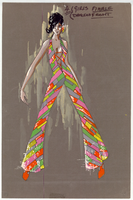
Costume design drawing, front view of multicolored lace-up jumpsuit with halter top, Las Vegas, 1967
Date
1967
Archival Collection
Description
Costume Details: Multicolor fluorescent jumpsuit with lace-up back and halter top and matching earrings made up of colored squares. Artist's notation: "4 Girls Finale, Dancers Front."
Show Name: Mad, Mod World
Performance Name: Finale
Site Name: Sahara Hotel and Casino
Show Name: Mad, Mod World
Performance Name: Finale
Site Name: Sahara Hotel and Casino
Image

Costume design drawing, hot pink mini-dress with green and yellow stripes, Las Vegas, 1967
Date
1967
Archival Collection
Description
Costume Details: Hot pink mini-dress buttoned down the front, with wide green belt with bronze buckle; dress is printed with yellow and green horizontal stripes above the belt and yellow and green vertical stripes below the belt; white calf-high boots with green cuffs, green dangling earrings, large white sunglasses and white and green oversized bracelet.
Show Name: Mad, Mod World
Performance Name: Finale
Site Name: Sahara Hotel and Casino
Show Name: Mad, Mod World
Performance Name: Finale
Site Name: Sahara Hotel and Casino
Image

Costume design drawing, topless brown and red Spanish flamenco costume with ruffles, red scarf and brimmed hat, circa 1965-75
Date
1965 to 1975
Archival Collection
Description
Costume Details: Almost topless brown female Spanish flamenco costume with red ruffled train on sheath skirt, open bolero jacket with red ruffles at cuffs, red scarf and brimmed hat with conchos. Has belt with conchos.
Image
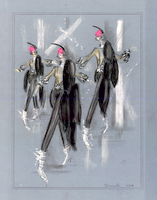
Costume design drawing, trio of dancers in black fur boas, gold trimmed tops and pink and black veiled headpieces, Las Vegas, 1978
Date
1978
Archival Collection
Description
Costume Details: Trio of ballet-style dancers in black tights, sheer black tops with belled sleeves, black fur boas, short white slouch boots, and hot pink hats trimmed with black feathers and veils.
Image
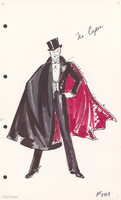
Costume design drawing, black tails and top hat with scarlet-lined cape, Las Vegas, 1981
Date
1981
Archival Collection
Description
Bob Mackie design. Handwritten text on drawing: "No capes." Transcribed from original drawing index: "16 Male Dancers (Tails)."
Costume Details: Male performer in black tails and top hat with white vest and bow tie and black cape lined in jeweled scarlet.
Show Name: Jubilee!
Performance Name: Bandwagon finale: Vienna
Site Name: MGM Grand Hotel and Casino
Costume Details: Male performer in black tails and top hat with white vest and bow tie and black cape lined in jeweled scarlet.
Show Name: Jubilee!
Performance Name: Bandwagon finale: Vienna
Site Name: MGM Grand Hotel and Casino
Image
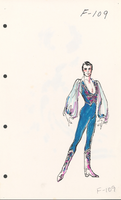
Costume design drawing, blue ballet costume for male dancer, Las Vegas, 1981
Date
1981
Archival Collection
Description
Bob Mackie design. Transcribed from original drawing index: "4 Principal boy dancers (Vienna, ballet look)."
Costume Details: Male dancer in blue ballet style costume with sheer ballooned sleeves; decorated with fuchsia trim; matching boots.
Show Name: Jubilee!
Performance Name: Bandwagon finale: Vienna
Site Name: MGM Grand Hotel and Casino
Costume Details: Male dancer in blue ballet style costume with sheer ballooned sleeves; decorated with fuchsia trim; matching boots.
Show Name: Jubilee!
Performance Name: Bandwagon finale: Vienna
Site Name: MGM Grand Hotel and Casino
Image
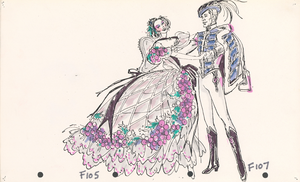
Costume design drawing, Vienna finale costumes, Las Vegas, 1981
Date
1981
Archival Collection
Description
Bob Mackie design. Transcribed from original drawing index: "16 Bluebells (Vienna hoopskirts); 16 Male dancers (Vienna-Military)."
Costume Details: Female performer in pale pink hoop skirt costume decorated with large fuchsia and purple grapes, black ribbons at waist, and teal hair ribbons. Male performer wearing a stylized military uniform costume with white tights, blue jacket, cape and hat trimmed with black feathers, and black boots.
Show Name: Jubilee!
Performance Name: Bandwagon finale: Vienna
Site Name: MGM Grand Hotel and Casino
Costume Details: Female performer in pale pink hoop skirt costume decorated with large fuchsia and purple grapes, black ribbons at waist, and teal hair ribbons. Male performer wearing a stylized military uniform costume with white tights, blue jacket, cape and hat trimmed with black feathers, and black boots.
Show Name: Jubilee!
Performance Name: Bandwagon finale: Vienna
Site Name: MGM Grand Hotel and Casino
Image
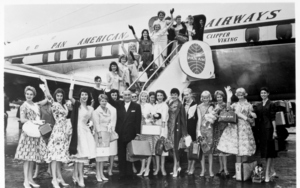
Photograph of Bluebells posing outside of Pan Am jet, 1958
Date
1958
Archival Collection
Description
The Bluebells dance troupe poses on the steps of a Pan Am jet plane as they arrive in Las Vegas to open the new Lido de Paris show at the Stardust Hotel. Other members of the Bluebells pose with Margaret Kelly ("Madame Bluebell") and Lido owner/producer Pierre-Louis Guérin on the tarmac below the plane. All are dressed in street clothes and some are holding small carry-on bags.
Show Name: Lido de Paris (Las Vegas, Nev.)
Show Name: Lido de Paris (Las Vegas, Nev.)
Image
Pagination
Refine my results
Content Type
Creator or Contributor
Subject
Archival Collection
Digital Project
Resource Type
Year
Material Type
Place
Language
Records Classification
